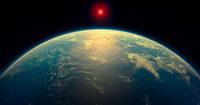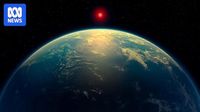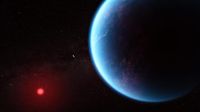Astronomers have detected the most promising "hints" of potential life on a planet beyond our solar system, K2-18b, which is located 124 light-years away in the Leo constellation. This groundbreaking discovery was made by a British-US team of researchers using the James Webb Space Telescope, where they identified two gases—dimethyl sulfide (DMS) and dimethyl disulfide—believed to be produced only by biological processes on Earth.
K2-18b, a massive exoplanet over eight times the mass of Earth and 2.5 times its size, orbits its star in the habitable "goldilocks" zone, a region neither too hot nor too cold for liquid water to exist. This zone is crucial for the possibility of life as we know it. The planet has long been considered a prime candidate for hosting microbial life due to its potential oceanic environment.
According to Nikku Madhusudhan, a Cambridge University astrophysicist and lead author of the study published in the Astrophysical Journal Letters, the findings could be transformative. "Frankly, I think this is the closest we have come to seeing a feature that we can attribute to life," he stated. He expressed optimism about confirming these signals within one to two years, provided they can secure additional observation time with the Webb telescope.
In 2023, the Webb telescope had already detected methane and carbon dioxide in K2-18b's atmosphere, marking the first time such carbon-based molecules were found on an exoplanet in a habitable zone. The recent observations revealed much stronger signs of DMS, although still below the "five sigma" threshold of statistical significance that scientists seek for definitive discoveries.
While the implications of these findings are significant, other scientists remain cautious. Raymond Pierrehumbert, a planetary physics professor at Oxford University, noted that K2-18b might be too hot for life as we know it, suggesting that if the planet had water, it would be "hellishly hot" and potentially uninhabitable. Similarly, Sara Seager, a professor of planetary science at MIT, highlighted previous claims of water vapor in K2-18b’s atmosphere that later proved to be incorrect.
Christopher Glein, principal scientist at the Space Science Division of the Southwest Research Institute, echoed the need for caution, stating, "Yet we must be very careful to test the data as thoroughly as possible." He emphasized that while the current findings are intriguing, they require further verification.
Hycean planets like K2-18b are not expected to host intelligent life; instead, they may harbor tiny microbes similar to those found in Earth's oceans billions of years ago. The presence of DMS, while suggestive of life, does not guarantee it, as last year scientists detected traces of the same chemical on a comet, indicating it can also be produced through non-organic processes.
Madhusudhan estimated that an additional 16 to 24 hours of observation time with the Webb telescope could help clarify the situation, potentially confirming the existence of these gases. "This could be the tipping point, where suddenly the fundamental question of whether we're alone in the universe is one we're capable of answering," he said, highlighting the significance of this research.
The discovery has reignited interest in the search for extraterrestrial life, a pursuit that has captivated scientists for decades. As researchers continue to analyze K2-18b and similar exoplanets, the prospect of finding life beyond our solar system appears more tangible than ever.
As the scientific community processes these findings, the debate over K2-18b's potential as a life-hosting planet will likely continue. The implications of discovering life elsewhere in the universe are profound, not only for science but for humanity as a whole. It raises fundamental questions about our place in the cosmos and the possibilities that lie beyond our home planet.
In conclusion, while the detection of DMS and DMDS on K2-18b is a significant step forward in the search for extraterrestrial life, it is essential to approach these findings with careful scrutiny and a commitment to rigorous scientific investigation. The journey to understanding life beyond Earth is just beginning, and K2-18b may hold the keys to unlocking this profound mystery.







